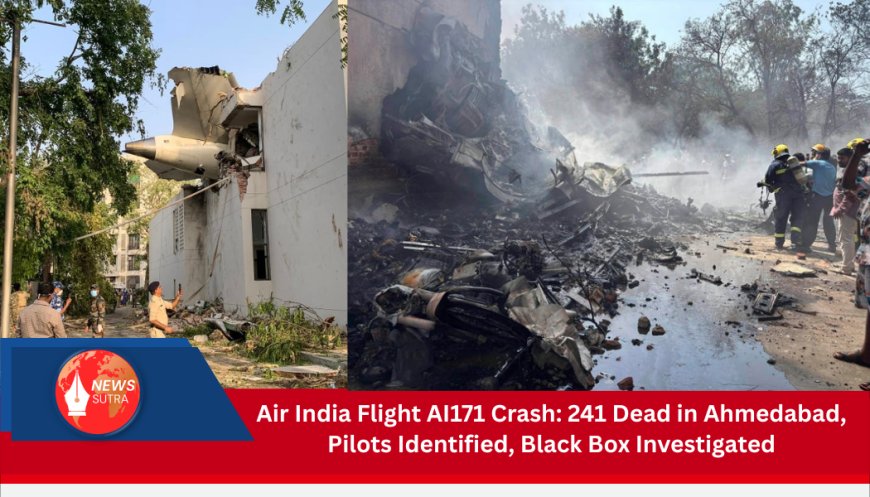Air India Flight AI171 Crash: 241 Dead in Ahmedabad, Pilots Identified, Black Box Investigated
Air India Flight AI171 crashed in Ahmedabad, killing 241. Captain Sumeet Sabharwal and FO Clive Kundar identified. One survivor. Preliminary findings suggest takeoff configuration error.

Ahmedabad, June 12, 2025 — A nation reels in shock as Air India Flight AI171, a Boeing 787 Dreamliner bound for London, crash-landed moments after takeoff from Ahmedabad’s Sardar Vallabhbhai Patel International Airport, claiming 241 lives. New details have emerged about the flight crew, passengers, and the probable sequence of failures that led to one of India’s worst aviation disasters in decades.
Pilots Identified: Seasoned Captain, Young First Officer
The ill-fated aircraft was commanded by Captain Sumeet Sabharwal, a 48-year-old senior pilot with more than 8,000 flight hours under his belt. Known in the aviation community for his disciplined flying and mentorship roles, Sabharwal had recently completed a Boeing simulation safety audit in Singapore just two months ago.
Accompanying him was First Officer Clive Kundar, 31, a relatively new but capable pilot with around 1,100 flight hours. Kundar’s recent training included long-haul emergency management under variable weather conditions. According to a family statement shared by actor Vikrant Massey, Kundar was his cousin and had just celebrated his daughter’s first birthday.
The Only Known Survivor: A Miracle in Seat 11A
Among the 242 onboard, only one person survived: Vishwash Kumar Ramesh, a British national seated near the emergency exit. He suffered severe injuries and was pulled from the burning wreckage by first responders. Hospital officials at Civil Hospital Ahmedabad report that Ramesh is conscious and stable but heavily sedated. His family has flown in from London and is receiving support from the Indian and British authorities.
Prominent Names Among the Dead
Tragically, the crash also claimed the life of former Gujarat Chief Minister Vijay Rupani, who was traveling on a diplomatic visa to attend a Commonwealth trade summit in the UK. His office confirmed the news late Thursday evening, triggering an outpouring of tributes across political circles.
In addition to passengers, over two dozen individuals on the ground were killed, including medical students living in the BJ Medical College hostel, which took the brunt of the aircraft’s final descent. At least five students were confirmed dead, with several others critically injured.
What Went Wrong: A Deadly Combination of Human and Mechanical Errors
Mayday Moments After Takeoff
The aircraft departed from Runway 23 at approximately 1:38 PM IST. Within seconds, it issued a Mayday call citing technical anomalies. Radar logs show that the aircraft failed to gain expected altitude, reaching only about 500 feet before veering off its flight path and crashing into the hospital complex adjacent to the airport.
Critical Configuration Error Suspected
Initial findings point to a configuration failure involving the aircraft’s flaps and landing gear. Surveillance and aviation footage reveal that the landing gear remained deployed and the wing flaps appeared to be retracted — a highly unusual state for a fully loaded aircraft attempting a long-haul takeoff. This would have dramatically reduced lift and increased drag, leading to what experts call a “lift starvation scenario.”
Multiple aviation engineers believe this oversight may have been the result of pilot error during pre-takeoff checks, a malfunction in the automated configuration warning system, or a combination of both. These systems are designed to alert the cockpit if flaps or gear are not in the correct position, but they can fail under specific electrical faults or override conditions.
Environmental and Load Factors
Compounding the technical issues were Ahmedabad’s scorching daytime temperatures — above 42°C — and the aircraft's full fuel load of over 100,000 liters, required for the intercontinental journey to London. This significantly increased the plane's takeoff weight, reducing its climb rate. Experts say even a slight misconfiguration under such conditions can be catastrophic.
Black Boxes Recovered, International Investigation Underway
Both the Flight Data Recorder (FDR) and Cockpit Voice Recorder (CVR) — the so-called “black boxes” — have been recovered and are being analyzed by a joint team from India’s DGCA, Boeing, and UK and US air safety boards. Early reports suggest that the voice recording captures a last-minute checklist callout and the sound of cockpit alarms shortly before the crash.
Preliminary findings are expected to be made public within 7 to 10 days.
National Response and Mourning
Prime Minister Narendra Modi expressed “profound grief and solidarity with the families of the victims.” Tata Sons, the parent group of Air India, has issued a statement promising full compensation, support for victims’ families, and complete cooperation with investigators.
Airports across the country are undergoing immediate operational audits. Several long-haul flights were temporarily grounded Thursday evening pending mechanical inspections.
What This Means for Indian Aviation
This is the first hull-loss incident involving a Boeing 787 Dreamliner in India and raises critical questions about flight preparedness, human-machine reliability, and heat stress on aviation systems. More broadly, it reopens discussions around infrastructure near urban airports, especially in densely populated areas.
The crash also puts a spotlight on India's rapidly growing aviation sector, which, despite high safety ratings, continues to face challenges involving pilot fatigue, training gaps, and regulatory strain.
In Closing
As rescue teams continue to sift through debris and investigators piece together cockpit data, one thing is clear: this tragedy has shaken the nation and the aviation world. More than 240 families now wait for answers — and accountability.














